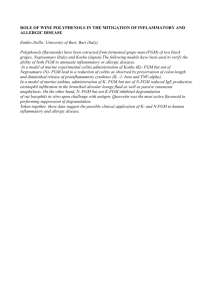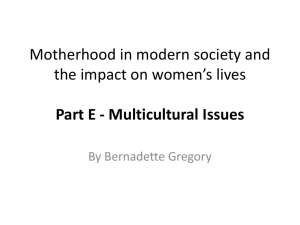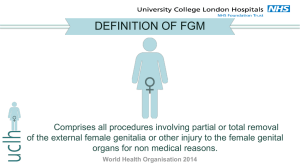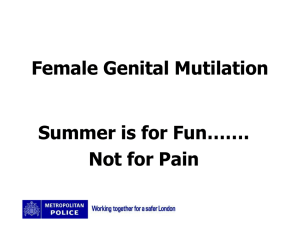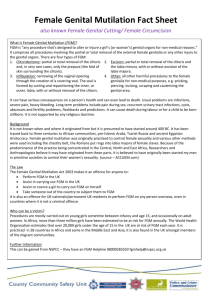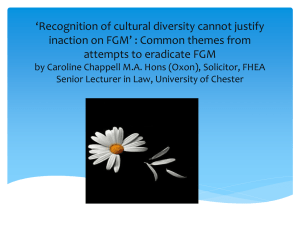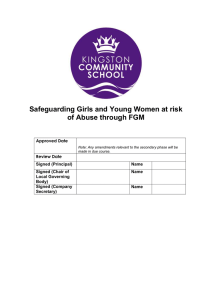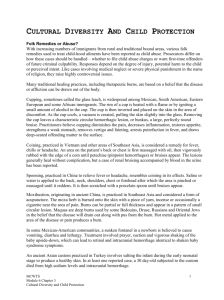Female Genital Mutilation: Outcomes and Alternatives
advertisement
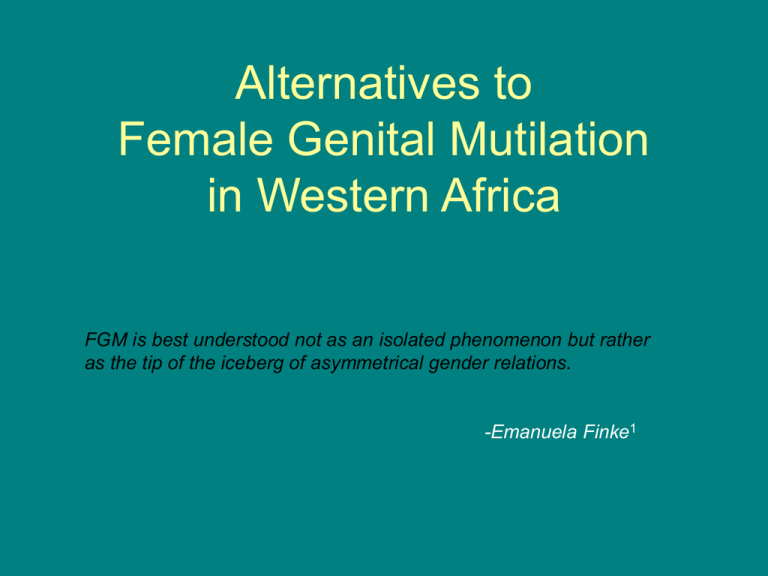
Alternatives to Female Genital Mutilation in Western Africa FGM is best understood not as an isolated phenomenon but rather as the tip of the iceberg of asymmetrical gender relations. -Emanuela Finke1 What is FGM? • Female Genital Mutilation, or FGM, is the traditional practice of cutting and/or removing parts of the female genitalia. • It is often viewed as a passage into womanhood and a necessity for marriage. • The WHO categorizes FGM into four types, from removing a part of the clitoris to full excision of the clitoris and cutting of the labia minora and majora, and artificial closure of the vagina. More information can be found at the WHO website. Where is FGM practiced? Image source: http://www.who.int/reproductive-health/fgm/fig1.htm Where is FGM practiced? • Practiced in 28 African countries, some others in the Middle East and Asia2 • WHO estimates 100-140 million girls have undergone FGM • 3 million girls per year are at risk Why is FGM practiced? • Tradition • Perceived religious requirement – (not actually required in any religion) • • • • • Marriage eligibility Rite of passage into womanhood Geography and neighbors’ practices Mark of status Lack of knowledge about medical consequences Arguments for the Elimination of FGM • Procedure is often performed in an unclean, unsterile environment • Women who perform procedure are often unskilled • Women are at risk for serious infections and complications • Most convincing argument is that most women who agree to procedure do so under heavy influence from friends and family A New Framework For Examination of FGM •Claire Chambers proposes first order and second order autonomy in order to examine the issue of FGM. •First order autonomy concerns the attitude one has to the rules and norms that are a part of life •A person is first-order autonomous if she critically examines rules and norms and follows only those that she endorses •Second order autonomy concerns the way that one comes to lead a particular way of life. A person is second-order autonomous if she chooses or endorses the overall conception of the good that she follows. Political Liberalism • Is inadequate in dealing with injustices resulting from culture • Prioritizes individuals’ ability to adhere to even those preferences which have been shown to be socially constructed and thus imperfect guides to justice • 1st order and 2nd order autonomy are better apt to address FGM A Closer Look: FGM in Senegal and Gambia The Case of Gambia • 60% of girls and women undergo the practice of FGM • Only after undergoing FGM is a girl rendered marriageable • Other reasons for FGM: chastity, rite of passage, social standing • The operation distinguishes those who have undergone the operation from those who have not. The Case of Gambia (con’t) • Studies have proven centrality of nuclear family/extended family in decision to undergo ceremonial cutting • Assumption that any girl who chooses to perform this practice is most likely second order autonomous Responsibilities of the State • Claire Chambers argues that state has a right to intervene on behalf of affected girls and women • She argues that FGM is a right infringement because girls and women are afforded little autonomy in which to decide whether or not to undergo the procedure • Argues that practice is unjust and unequal Fig. 1 Tostan in Senegal • Started in 1997 in Senegal as a community empowerment program • Not initially meant to stop FGM, but has since been successful in over 2000 communities • Implements a 4-pronged education approach: – Women’s health, problem solving, hygiene, and human rights Tostan in Senegal • Relies on community rather than individual decision-making • Uses traditional teaching methods: drama, music, discussions • Public “abandonment” ceremony with multiple villages hold communities accountable for their decisions4 Implications • Tostan is successful because it teaches the skills and knowledge to create social change in the community, rather than applying Western ideals to African society • The FGM-abandonment program was conceived of by women in Tostan’s first education program - Tostan facilitates and supports their curriculum • Knowledge and choice makes the program effective, more than any other characteristic References • • • • • • • • • • • • • • • Finke, Emanuela. Genital Mutilation as an Expression of Power Structures: Ending FGM through Education, Empowerment of Women and Removal of Taboos. African Journal of Reproductive Health, Vol. 10, No. 2, August, 2006, pp. 13-17 Tostan. Tostan Resources on Female Genital Cutting. http://tostan.org/web/page/644/sectionid/548/pagelevel/3/interior.asp WHO. Female Genital Mutilation. http://www.who.int/reproductive-health/fgm/index.html. Diop, Nafissatou J.,Modou Mbacke Faye, Amadou Moreau, Jacqueline Cabral, Hélène Benga, Fatou Cissé, Babacar Mané, Inge Baumgarten, and Molly Melching. The TOSTAN Program: Evaluation of a Community Based Education Program in Senegal. August, 2004. Chambers, Claire. Sex, Culture and Justice. University Park: The Pennsylvania State University Press, 2008 Gehring, Verna V., ed. The Ethical Dimensions of Global Development. Lanham: Rowman & Littlefield Publishers, Inc., 2007 Female Genital Mutilation in Gambia.2002 Zuhur, Sherifa. Gender, Sexuality and the Criminal Laws in the Middle East and North Africa: A Comparative Study. Istanbul: Women for Women’s Human Rights (WWHR), 2004. Omeje, Kenneth, ed. Reproductive Health in South-Eastern Nigeria. Enugu: Institute For Developmental Studies, 2000. Gachiri, Ephigenia W. Female Circumcision. Limuru: Kolbe Press, 2000. Denniston, George and Marilyn Fayre Milos, ed. Sexual Mutilations. New York: Plenum Press, 1997. Lockhat, Haseena. Female Genital Mutilation. Enfield: Middlesex University Press, 2004. Worton, Michael and Nana Wilson-Tagoe, ed. National Healths. Portland, 2004. “Figure 1” http://www.statehouse.gm/kids/girlchild/index.html
